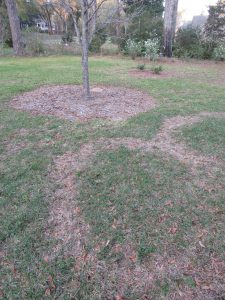Mushrooms often are grouped in a circle in your lawn. This is due to the circular release of spores from a central mushroom. “Fairy Ring” is a term used to describe this phenomenon. Fairy rings can be caused by multiple mushroom species such as Chlorophyllum spp., Marasmius spp., Lepiota spp., Lycoperdon spp., and other basidiomycete fungi.
Occurrence
Fairy rings most commonly invade your yard during the summer months, when the Florida panhandle receives the most rain. The mushrooms cause the development and spread of the rings by the release of spores. Spores produce more mushrooms and are similar to the seed produced by plants.
Fairy Ring “Types”
Fairy rings can be seen in three forms:
- Type I rings have a zone of dead grass just inside a zone of dark green grass. Weeds often invade the dead zone.
- Type II rings have only a band of dark green turf, with or without mushrooms present in the band.
- Type III rings do not exhibit a dead zone or a dark green zone, but a ring of mushrooms is present.
The size and fill of rings varies considerably. Rings are often 6 ft or more in diameter. The fill of a ring can range from a quarter circle to a semicircle or full circle.
Cultural Controls
The rings will disappear naturally, but it could take up to five years. Although it is possible to dig up the fairy ring sites, it is a good possibility the rings will return if the food source (buried, rotting wood or other organic matter) for the fungi is still present underground.
In some situations, the fungi coat the soil particles and make the soil hydrophobic (meaning it repels water), which will result in rings of dead grass. If the soil under this dead grass is dry but the soil under healthy grass next to it is wet, then it is necessary to aerate or break up the soil under the dead grass with a pitchfork or other cultivation tool.
Chemical Controls
Effective fungicides include products containing the active ingredients azoxystrobin, flutolanil, metconazole, pyraclostrobin, and triticonazole.
Fungicides inhibit the fungus only. They do not eliminate the dark green or dead rings of turfgrass and do not solve the dry soil problem.
A homeowner’s guide to lawn fungicides can be found at the University of Florida/IFAS Extension Electronic Data Information Source (EDIS) website (http://edis.ifas.ufl.edu/document_pp154).
- Is a Limequat a Lime or a Kumquat? - December 26, 2025
- Gardening in the Panhandle LIVE! Program Summary: Pests of Florida Lawns and Landscape Plants - May 28, 2025
- Fun Facts About Ferns - April 30, 2025


